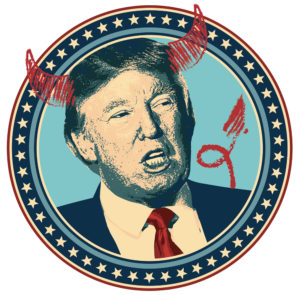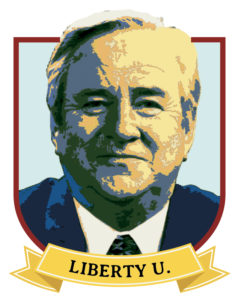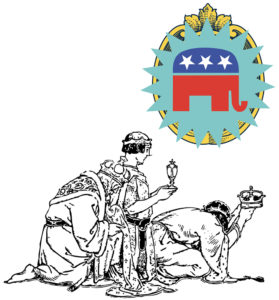Dance with the Donald What Evangelicals’ Infatuation with Trump Portends for Religion in America

With Donald J. Trump in the White House, conservative white evangelicals have never had it so good. Trump picked one of their own as his vice president, grants their media special favored access, and gives their leaders the keys to the kingdom, so to speak.
The affection runs both ways. Appearing on Fox News, Jerry Falwell Jr., whose father launched the religious right, declared “we have found our dream president.” Since he entered the presidency, Trump’s popularity has waned with virtually every other demographic group, but not with white evangelicals. Despite the lurid Stormy Daniels revelations and a host of other scandalous allegations, a Public Religion Research Institute poll conducted in March found that their support for Trump has climbed from 40 percent in early 2016 to an all-time high of 75 percent, nearly twice that of the general public. It’s an astonishing turn for America’s leading religious brand.
No one is more gobsmacked than evangelical Michael Gerson, a former speechwriter for President George W. Bush. Writing in the Atlantic, he notes with disgust:
there appears to be no limit to what some evangelical leaders will endure. Figures such as Falwell and Franklin Graham followed Trump’s lead in supporting Judge Roy Moore in the December Senate election in Alabama. These are religious leaders who have spent their entire adult lives bemoaning cultural and moral decay. Yet they publicly backed a candidate who was repeatedly accused of sexual misconduct, including with a fourteen-year-old girl.
 “The president of the United States has paid hush money to a porn star—apparently to cover up a tryst that occurred shortly after the birth of his son….I’m sorry, but you cannot compartmentalize this behavior, declare that it’s ‘just politics,’” thundered National Review Senior Correspondent David French recently. “It’s sin, and it’s sin that is collapsing the Evangelical moral witness.”
“The president of the United States has paid hush money to a porn star—apparently to cover up a tryst that occurred shortly after the birth of his son….I’m sorry, but you cannot compartmentalize this behavior, declare that it’s ‘just politics,’” thundered National Review Senior Correspondent David French recently. “It’s sin, and it’s sin that is collapsing the Evangelical moral witness.”
Meantime, the rise of the “nones” (people who identify as religiously unaffiliated) and the decline of orthodox Christian belief continues apace. The Pew Research Center finds that although most people in the United States continue to say they believe in God, when pressed only 56 percent say they believe in God “as described in the Bible.” Clearly something has to give. Are we witnessing the end times for white conservative religion in America, or the red dawn of theocracy? The question could hardly be more momentous.
For answers, we have to go back to the origins of this hodgepodge of born-again Protestant sects. Its roots lie in the Puritan communities that dotted the early colonies, but American evangelicalism flowered in the early nineteenth century with the Second Great Awakening, a Protestant revival that drew millions of common people who felt excluded from snobbish mainline churches.
Then as now, class resentment played a role. Richard Kyle, a historian of evangelicalism at Tabor College in Kansas, writes that in the period just after the American Revolution, church membership in the northern states was sparse and selective. But the new republic’s guarantee of freedom of religion created a market opportunity.
Starting around 1800, itinerant preachers began to hold outdoor revival meetings. In contrast to highly educated ministers preaching doctrine to the pews, these outdoor evangelicals focused on individual sin, redemption, and salvation. They made use of soaring rhetoric, fear, promise, and, says Kyle, pop culture. It proved a popular and durable formula. Revivals drew huge crowds and led to the establishment of many new churches.
But from the start the movement was tangled in contradiction and irony. Although it was largely a reaction against elite Enlightenment figures such as Benjamin Franklin and Thomas Jefferson—both of whom were scientists as well as politicians—evangelical churches in the North soaked up some of the Enlightenment’s key principles and became progressive.
In his 2006 book Evangelicalism: an Americanized Christianity, Kyle writes that “What emerged in the years after the American Revolution as the dominant intellectual trend was a Christianized form of the Enlightenment.” The absorption of the ideals of equality and individual freedom set the stage for a dramatic new development—one that would embody the greatest contradiction of all.
The Second Great Awakening brought with it a change in attitudes toward slavery in the North. Until then, “Slavery could be found in every colony,” writes Harvard historian of religion Catherine Brekus.
Although evangelical ministers do not seem to have realized it (and in fact many of them owned slaves themselves), [they] undermined their own message of human sinfulness and helplessness by insisting that white masters had a god-given right to own and control their own slaves.
As American evangelicalism was taking shape, its counterpart in Britain sparked what would become the most significant reform of the nineteenthth century: abolition. Led by evangelical William Wilberforce, a member of Parliament from Yorkshire, the campaign against the hugely profitable slave trade had its first major success in 1807 with the passage of an act that prohibited transporting slaves across the Atlantic for sale in the Americas. The campaign in Britain ground on until 1833, when slavery became illegal throughout the British Empire (except in India and some other Asian colonies).
Wilberforce’s triumph in Britain inspired Northern evangelicals along with other opponents of slavery in the United States. In 1833 the American Anti-Slavery Society formed in Philadelphia under the slogan “Slaveholding is a heinous crime in the sight of God.”
But if evangelicals were a driving force in the abolition movement in the North, they were at the same time the leading defenders of slavery in the South. There, evangelical ministers voiced the strongest available argument in favor of the euphemistically labeled “peculiar institution”—God’s will. In 1838, for example, Baptist minister Richard Furman of South Carolina published an essay pointing to the Bible’s numerous endorsements of slavery. “In proving this subject justifiable by Scriptural authority,” he wrote, “its morality is also proved; for the Divine Law never sanctions immoral actions.”
Meantime, the abolitionist movement became evermore evangelical. In 1844, a former merchant marine named Jonathan Walker attempted to smuggle seven escaped slaves aboard a sailing vessel out of Pensacola, Florida, bound for the Bahamas, where they could live free. Unfortunately, having already earned a reputation for befriending blacks, Walker was under watch. Bounty hunters intercepted his vessel. What happened to the slaves was surely barbaric, and Walker was jailed for a year and branded on his palm with the letters “SS”—for slave stealer.
That event inspired abolitionist John Greenleaf Whittier to write a poem that soon became famous across the land. Florid and religious in its language, “The Branded Hand” includes the stirring lines:
Then lift that manly right-hand, bold ploughman of the wave!
Its branded palm shall prophesy, “Salvation to the Slave!”.
…
Can a Christless church withstand,
In the van of Freedom’s onset, the coming of that hand?
The clashing worldviews came to a cataclysmic end in the Civil War. Fast forward to the 1960s. As that decade unfolded, a series of shocks to the sensibilities of conservative white Christians began: the ban on public school prayer, desegregation, anti-discrimination legislation, and the rise of the women’s liberation movement, to name a few. In 1973 the Supreme Court ruled in Roe v. Wade that women had a right to choose abortion. And with that, so the story goes, the religious right was born.
In a 2005 memoir, the late Jerry Falwell writes: “I sat there staring at the Roe v. Wade story, growing more and more fearful of the consequences…and wondering why so few voices had been raised against it.” The time had come for evangelicals to get back in the political game.
Baloney, says historian Randall Balmer. What actually fired up right-wing evangelical leaders like Falwell was a series of court decisions declaring that any institution practicing racial segregation or discrimination couldn’t qualify as a charitable organization. Ultimately the Supreme Court would rule against Bob Jones University on the same grounds. “The IRS started going after segregation academies,” says Balmer. “That’s what got the attention of Falwell and others. It had nothing do with abortion.”
Formerly a professor at Barnard College and Columbia University, now at Dartmouth, and the author of numerous books on evangelicalism, Balmer points to clear evidence that opposition to abortion rights was nowhere on the evangelical radar at the time of Roe v. Wade. “In 1971 the Southern Baptist Convention, not exactly a redoubt of liberalism, passed a resolution calling for the legalization of abortion,” he said in an interview for this story, “a resolution they reaffirmed in 1974, and again in 1976.”
The Roe v. Wade decision not only failed to stir an uprising, it was embraced by many evangelicals at that time. What’s more, in the North an effort to revive evangelicalism’s social progress agenda took off that same year. In the wake of the Civil Rights movement and women’s rising status, evangelicals were changing.
Rev. Jim Wallis, now head of the Sojourners organization, says they went “from being focused mostly on personal issues to social justice.” He was one of fifty-three evangelical leaders who signed the Chicago Declaration of Evangelical Social Concern, a document that deplores racism, sexism, and indifference to poverty.
So what happened to that social justice revival? Jimmy Carter, himself a liberal Southern Baptist, was elected president in 1976, and the right wing of the Republican Party went to work on ousting him.
As Wallis tells it, those responsible “weren’t religious figures, they were political operatives with the best technology available at the time, which was direct mail.” What they needed, however, was a receptive mass audience.
Richard Viguerie, a GOP consultant seen as a direct-mail genius, “went to Falwell and Robertson and said, give me your lists, and I’ll make you a household name,” Wallis recalls. “He promised to make them famous, and he did.” As for the masses of white evangelicals, as Wallis sees it, “They’ve been the victims of a political takeover.”
 Political scientist Nancy Wadsworth of the University of Denver doesn’t buy the view that evangelicals were passive victims of a conspiracy between ambitious preachers and political strategists. To win back office in the aftermath of Watergate, the Republican Party needed a broader white base, she said in an interview. “They can’t do it all with class elites,” she said, so they set out to appeal to the fears and resentments of white evangelicals. “But it wouldn’t have worked if the rhetoric didn’t resonate.”
Political scientist Nancy Wadsworth of the University of Denver doesn’t buy the view that evangelicals were passive victims of a conspiracy between ambitious preachers and political strategists. To win back office in the aftermath of Watergate, the Republican Party needed a broader white base, she said in an interview. “They can’t do it all with class elites,” she said, so they set out to appeal to the fears and resentments of white evangelicals. “But it wouldn’t have worked if the rhetoric didn’t resonate.”
As the 1980 presidential race took shape, Republican strategists such as Paul Weyrich pointed out that abortion was a far more palatable issue than race. Not that race had to be abandoned altogether. George Wallace’s “segregation now, segregation forever” presidential bid had failed, but Richard Nixon’s “Southern strategy” of appealing to whites through coded phrases such as “law and order” had worked.
That kind of coded messaging developed into what’s now known as “dog-whistle politics.” One of the main notes on the GOP’s dog whistle has been “family values,” which can sound neutral to a mainstream audience while transmitting virulent anti-gay, anti-feminist, and racist undertones to target audiences. Wadsworth says that “family values” was crafted to appeal to conservative white evangelicals in the South without being explicitly hateful. “Patriarchy is part of Southern tradition, along with racism, but by fronting ‘family values,’ evangelicals got away with being ‘unraced.’”
Even as a racial reconciliation effort got underway among evangelicals, leaders of what had come to be known as the religious right built media empires and used them to stoke paranoia and xenophobia in their largely white evangelical audiences.
On the Christian Broadcast Network, Pat Robertson told his growing audience, “Just what Nazi Germany did to the Jews, so liberal America is now doing to evangelical Christians.” Jerry Falwell used the same degraded metaphor in an even more absurd comparison: “The ACLU is to Christians,” he claimed, “what the American Nazi party is to Jews.”
Whipping up anti-abortion and anti-gay fervor under the banner of “family values” also had the political virtue of bringing right-wing Catholics into coalition with those evangelicals who as late as the Kennedy presidency had been condemning them as papists. By 2012 Newt Gingrich, a Catholic convert, would sweep the Southern strongholds of evangelicalism.
The apocalyptic rhetoric, self-pitying narrative, and theological flexibility set the stage for a flamboyantly impious figure to grab the mic. Donald Trump did that and more. He freed the conservative white evangelical movement from the muzzle of coded language and moral inhibition. In announcing his run for the presidency, the reality TV star and former pro-wrestling impresario branded Mexicans rapists and claimed that the world was laughing at us.
“Trump is a master at the rhetoric of victimization,” Balmer notes, “and evangelicals have been responding to that kind of rhetoric for decades. ‘It’s our values that are under attack, we are the ones who are being marginalized.’”
With Trump condemning political correctness and encouraging political violence at his rallies, all constraints were broken. Virulent racism was on full display. Trump himself mocked the disabled, despised the poor, and was exposed as the crudest kind of philanderer.
Yet, he remains the darling of conservative white evangelicals—and not just in the South. Wadsworth notes that the increased mobility of post-war Americans meant that Southern white evangelicalism spread across the rest of the country. What had been a regional theology became suburban tinder everywhere.
That tinder was ignited by the spread of right-wing media, from the ostensibly “fair and balanced” Fox News to the apocalyptic Christian right radio stations that have popped up, ironically, on the left side of the FM band across the country.
The evangelical embrace of Trump carries a price, however. As Gerson, French, and Wallis affirm, it has deeply offended those who take their theology seriously. “You cannot support Jesus Christ and support Donald Trump,” Wallis declares. “You can’t do it. He is antithetical to all that Jesus stood for.”
Along with other left-leaning evangelicals, Wallis is attempting to hoist the social justice banner once again with a “Reclaiming Jesus” movement. They plan a minister-led march on Washington, DC, this summer. Their declaration can be found at reclaimingjesus.org.
 For centuries, one of the few things that characterized all evangelicals was piety, historian Balmer notes. That’s over. “I just don’t see how anyone can ascribe moral credibility to this movement after the embrace of Donald Trump.”
For centuries, one of the few things that characterized all evangelicals was piety, historian Balmer notes. That’s over. “I just don’t see how anyone can ascribe moral credibility to this movement after the embrace of Donald Trump.”
It has divided the movement generationally as well. The median age of Fox News viewers is an astonishing sixty-eight, and while it would be an exaggeration to say that young white evangelicals have turned their backs on their Trump-allied elders, it seems highly unlikely that most young evangelicals will find a comfortable place in their generation as racist, misogynistic, homophobes. Nor do many want to. In stark contrast to their elders, nearly 70 percent of young white evangelicals admit that Muslims face a lot of discrimination in our country. Growing numbers are embracing a racially diverse, socially engaged evangelicalism, such as the Red Letter Christians movement.
As a political movement, Trump’s base may still continue to wield some clout. The communications expertise that fueled the rise of the religious right has attained new sophistication with the advent of social media. Right-wing politics isn’t going away.
But as for the culture wars that mobilized conservative white Christians over the past several decades? Considering that they have alienated their own youth, rekindled racism, and repelled their brethren in immigrant communities, Wadsworth says, “I think Donald Trump may be the death knell for evangelicals”—at least in their current and undeniably creaky form.
